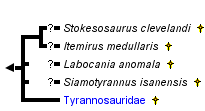Tyrannosauroidea
Tyrant dinosaurs and their possible relatives
Thomas R. Holtz, Jr.


This tree diagram shows the relationships between several groups of organisms.
The root of the current tree connects the organisms featured in this tree to their containing group and the rest of the Tree of Life. The basal branching point in the tree represents the ancestor of the other groups in the tree. This ancestor diversified over time into several descendent subgroups, which are represented as internal nodes and terminal taxa to the right.

You can click on the root to travel down the Tree of Life all the way to the root of all Life, and you can click on the names of descendent subgroups to travel up the Tree of Life all the way to individual species.
For more information on ToL tree formatting, please see Interpreting the Tree or Classification. To learn more about phylogenetic trees, please visit our Phylogenetic Biology pages.
close boxIntroduction
Tyrannosauroidea (as used here) is defined as Tyrannosaurus and all taxa closer to it than to Ornithomimus or to Deinonychus. This clade thus contains Tyrannosauridae, and may also encompass several poorly known taxa. These forms are mentioned below:
Stokesosaurus clevelandi from the Morrison Formation (Late Jurassic Epoch, Kimmeridgian Age) of Utah, USA, is known from the type ilium, a premaxilla (Madsen 1974), and a partial braincase (Chure and Madsen 1998). All specimens were recovered from the same quarry. Madsen (1974) provisionally refered this 2-3 m long dinosaur to Tyrannosauridae because of the presence of a single midline iliac crest dorsal to the supracetabular crest, and because of incipient development of a ventral hooklike projection amd medial support on the preacetabular blade. Additionally, features of the referred braincase and premaxilla resemble those of tyrannosaurids.
Itemirus medullaris from the Central Kyzlkuum Sands (Late Cretaceous, late Turonian Age) of Dzhara-Kuduk, Itemir, Uzbekistan, is known only from a braincase (Kurzanov 1976). It shares with Stokesosaurus in the presence of very deep pockets on the lateral surface of the basipterygoid process.
Labocania anomala from the Campanian La Bocana Roja Formation (Late Cretaceous, Campanian stage) of Baja California, Mexico, is known from a frontal, quadrate, incomplete maxilla and dentary, chevron, proximal part of an ischium, metaratarsal II, and other fragments. It resembles tyrannosaurids in the presence of a hollow quadrate, a triangular obturator process on the ischium, and the semicircular scar on the caudolateral surface of the proximal ischium (Molnar 1974). However, these same features are also known in other coelurosaurs (Holtz in press a). In other features (of the frontal and quadrate) however, it resembles abelisaurid ceratosaurs.
Siamotyrannus isanensis is known from the pelvis, five dorsal vertebrae, sacrum, proximal caudal series, and chevrons from the Sao Khua Formation (Early Cretaceous, Barremian Age) of northeastern Thailand (Buffetaut et al. 1996). The size of the specimens suggest an animal over 6 m long. Buffetaut et al. (1996) referred Siamotyrannus on the similarity in the form of the ilium and a semicircular scar on the caudolateral portion of the ischium. However, unlike tyrannosaurids the midline crest of the ilium is a pair of crests. However, the obturator notch of the pubis is partially enclosed by a cranially-oriented hook, unlike the condition in coelurosaurs. If Siamotyrannus does prove to be a tyrannosauroid, it lacks many of the derived featuers shared by all known tyrannosaurids, and indeed preliminary phylogenetic analysis shows that it lies outside the clade comprised of all descendants of Aublysodon and Tyrannosaurus and is thus not a member of Tyrannosauridae proper (Holtz in press b).
Discussion of Phylogenetic Relationships
Other than Tyrannosauridae proper, several fragmentary fossil forms have been considered as possibly closer to tyrant dinosaurs than to other known theropod clades. Their precise position among the coelurosaurs has yet to be subjected to phylogenetic analysis, however.
Stokesosaurus clevelandi and Itemirus medullaris share presence of very deep pockets on the lateral surface of the basipterygoid process. This derived feature may indicate a sister taxon relationship between these species, regardless of their position relative to Tyrannosauridae (Chure and Madsen 1998).
References
Buffetaut, E., Suteethorn, V., and Tong, H. 1996. The earliest knwon tyrannosaur from the Lower Cretaceous of Thailand. Nature 381: 689-691.
Chure, D. J., and Madsen, J. H. 1998. An unusual braincase (?Stokesosaurus clevelandi) from the Cleveland-Lloyd Dinosaur Quarry, Utah (Morrison Formation; Late Jurassic). Journal of Vertebrate Paleontology 18: 115-125.
Holtz, T. R., Jr. in press a. Tyrannosauridae. In: Weishampel, D. B., Dodson, P., and Osmólska, H. (eds.). The Dinosauria. Second Edition. University of California Press, Berkeley.
Holtz, T. R., Jr. in press b. The phylogeny and taxonomy of the Tyrannosauridae. In: Carpenter, K., and Tanke, D. (eds.). Mesozoic Vertebrate Life. Indiana University Press.
Kurzanov, S. M. 1976. [Braincase structure in the carnosaur Itemirus n. gen and some aspects of the cranial anatomy of dinosaurs]. Paleontologicheskii Zhurnal 1976: 127-137. (In Russian)
Madsen, J. H. 1974. A new theropod dinosaur from the Upper Jurassic of Utah. Journal of Paleontology 48: 27-31.
Molnar, R. E. 1974. A distinctive theropod dinosaur from the Upper Cretaceous of Baja California (Mexico). Journal of Paleontology 48: 1009-1017.
About This Page
Thomas R. Holtz, Jr.

University of Maryland, College Park, Maryland, USA
Page copyright © 2000
All Rights Reserved.
- First online 29 August 2000
Citing this page:
Holtz, Jr., Thomas R. 2000. Tyrannosauroidea. Tyrant dinosaurs and their possible relatives. Version 29 August 2000 (under construction). http://tolweb.org/Tyrannosauroidea/15714/2000.08.29 in The Tree of Life Web Project, http://tolweb.org/





 Go to quick links
Go to quick search
Go to navigation for this section of the ToL site
Go to detailed links for the ToL site
Go to quick links
Go to quick search
Go to navigation for this section of the ToL site
Go to detailed links for the ToL site